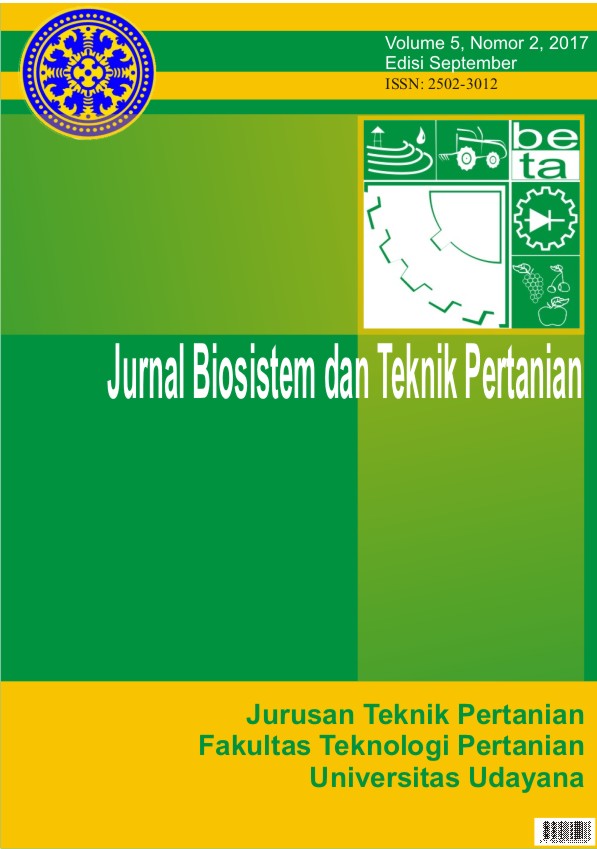Pengaruh Lama Waktu Cekaman Anaerobik Dan Konsentrasi Emulsi Lilin Lebah Sebagai Bahan Pelapis Terhadap Mutu Dan Masa Simpan Buah Tomat
Abstract
Tomat (Lycopersicon esculentum Mill) termasuk golongan tanaman sayur yang dapat tumbuh di daerah subtropis dan daerah tropis. Buah tomat sangat ringkih mengalami kerusakan selama periode pascapanen. Untuk memperpanjang masa simpan buah tomat dapat dilakukan dengan pelapisan menggunakan bahan edible. Lilih lebah adalah salah satu bahan yang aman dikonsumsi dan dapat digunakan sebagai bahan pelapis pada buah. Cekaman anaerobik yang diberikan pada buah tomat bertujuan untuk mengreasi senyawa volatile anaerobik untuk memperlambat laju kemunduran buah selama periode pascapanen dengan demikian, memperpanjang masa simpan. Pada kondisi anaerobik, ethanol dan acetaldehyde adalah senyawa volatile yang secara alami diproduksi dari buah dan sayuran. Penelitian ini bertujuan untuk mengetahui dua faktor perlakuan, yaitu lama cekaman anaerobik dan konsentrasi emulsi lilin lebah (o/w), sebagai bahan pelapis, terhadap mutu dan masa simpan buah tomat. Hasil penelitian menunjukkan, pengaruh dua faktor perlakuan tersebut secara nyata berinteraksi terhadap mutu dan masa simpan. Cekaman anerobik selama 36 jam dikombinasikan dengan konsesntrasi emulsi lilin lebah berbeda (1.5 dan 3.0%) sebagai bahan pelapis, memperlambat kemunduran mutu dan memperpanjang masa simpan buah tomat. Akan tetapi, bila lama cekaman 72 jam yang dikombinasikan dengan perlakuan pelapisan emulsi lilin lebah 3%, intensitas kerusakan buah meningkat.
Tomato (Lycopersicon esculentum Mill) is classified as one of fruity vegetables which could grow both sub-tropical region and tropical region. Tomato fruits are naturally prone to damage during the postharvest period. Extending the shelf-life of the fruits could be done by using edible natural coating. Beeswax is one of the natural edible materials that could be applied for fruit coating which is safe to be consumed. Anaerobic stress given to the fruits aimed to create suitable anaerobic volatiles to reduce the deterioration rate during the postharvest period; therefore, prolong the shelf-life. In anaerobic condition, ethanol (ethyl alcohol) and acetaldehyde are volatile compounds which are naturally produced from fruits and vegetables. This research was aim to investigate the effect of two different factors of treatments, namely the length of time of anaerobic stresses and different concentration of beeswax emulsion (o/w), as a coating material, on the quality and storage life of tomato fruits.The result showed that the effect of the both factors of treatments were significantly interacted on the deterioration of quality and storage life of tomato fruits. The length of anaerobic stress of 36 hrs combining with different concentration (1.5 and 3.0%) of beeswax emulsion as a coating material slowed the deterioration of quality and increased the storage life of tomato fruits. However, if the length of stress of 72 hrs combined with concentration of beeswax emulsion of 3%, the intensity of fruit damage increased.
Downloads
References
Adaskaveg, J.E., Foster, H., Sommer, N.F. 2002.Principles of Postharvest Pathology and Management Decay of Edible Horticultural Crops. In Kader A. (Edt). Postharvest Technology of Horticutural Cps (4th Ed).UC DANR Pub 3311. Oakland, CA.
Boersig, M.R., Kader, A.A., Romani, R.J. 1988. Aerobic-anaerobic respiratory transition in pear fruit and cultured pear fruit cells. J.Am. Soc. Hort. Sci .111:869–873.
Harjadi, S.S., dan H. Sunarjono, 1990. Budidaya tomat. Dalam S.S. Harjadi (ed), Dasar-dasar Hortikultura (hal. 1-26). Bogor. Jurusan Budidaya Pertanian. Faperta-IPB.
Huelin FE, Coggiola IM (1968) superficial scald, a functional disorder of stored apples. IV. Effect of variety, maturity, oiled wraps and diphenylamine on the concentration of α-arnesene in the fruit. J Sci Food Agric 19:297–301.
Kismaryanti, A. 2007.Aplikasi Gel Lidah Buaya (Aloe vera) Sebagai Edible Coating Pada Pengawetan Tomat (Lycopersicon esculentum) .Tidak Dipublikasikan. Fakultas Teknologi Pertanian. Institut Pertanian Bogor. Bogor.
Kremer, Fr. & Unterstenhofer, G. (1967): De l’ emploi de la metode de Townsend et Heuberger dans l’interpretation de results d’essais phytosanitares. Pflanzenschutz Nachrichten, Bayer 4: 625–628.
Klieber, A., Ratanachinakorn, B., Simone, D. H. 1996. Effect of low oxygen and high carbon dioxide on tomato cultivar ‘Bermuda’ fruit physiology and composition. Sci Hort 65:251–261.
McGregor B.M. 1989. Tropical Products Transport Handbook.USDA Office of Transportation, Agricultural Handbook 668.
Nussinovitch, A., Marmur, T., Elkind, Y. 2013. Edible coating for plant matter. Paten WO2013144961 A1.
Rangana, S.C. 1979. Manual of Analysis of Fruit and Vegetable Products.Tata MsGrow Hill Pub. Co. Ltd. New Delhi, India.
Saltveit, M.E., Sharaf, A.R. 1992. Ethanol inhibits ripening of tomato fruit harvested at various degrees of ripeness without affecting subsequent quality. J.Amer.Soc.Hort.Sci. 117 (5): 793-798.
Weichmann, J. 1986. The effect of controlled atmosphere storage on the sensory and nutritional quality of fruits and vegetables. Hort Rev 8:101–127.












 Jurnal BETA (Biosistem dan Teknik Pertanian)
Jurnal BETA (Biosistem dan Teknik Pertanian)


